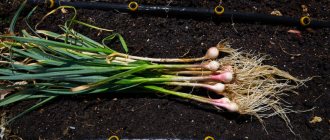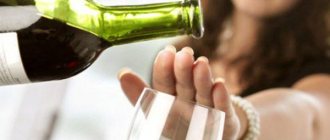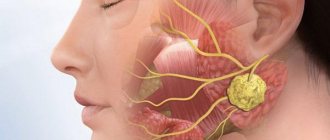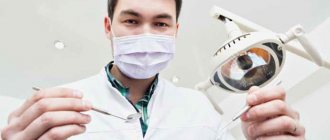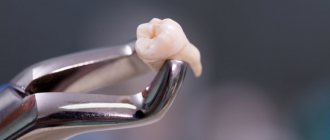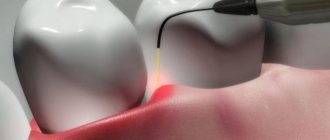June 26, 2017
After tooth extraction, pain will certainly occur, the wound will bleed a little, and swelling will appear. In order to cope with all the unpleasant consequences of the operation, UltraSmile. ru lists the TOP 10 remedies that will help you recover after tooth extraction - but it is recommended to use them only on the recommendation of a doctor; self-medication is not allowed. We will deliberately not indicate the names of antibiotics in this list, since they are used extremely rarely and are prescribed only by a dentist.
Pain after tooth extraction
Painkillers
"Ibuprofen"
A non-steroidal anti-inflammatory drug after tooth extraction, which has a fairly strong analgesic effect. Available in tablet form. Prohibited for use by children under 6 years of age, pregnant and lactating women. A single dose is 600-800 mg, the drug can be taken up to 4 times a day, but not longer than 5 days in a row. An analogue is Nurofen, the active ingredient of which is ibuprofen.
Ibuprofen
"Solpadeine"
The active ingredients of the drug are paracetamol, codeine and caffeine. Paracetamol has an antipyretic effect, codeine has an analgesic effect, and caffeine has a general tonic effect. The drug is contraindicated in children under 12 years of age, pregnant and lactating women, as well as patients with impaired liver and kidney function. It acts quite quickly, it should be taken after meals, 1 tablet 3-4 times a day.
Solpadeine
"Ketanov"
One of the most popular and quite powerful drugs for pain relief. The active substance, ketorolac, can block almost any pain. The drug is contraindicated during pregnancy, breastfeeding, impaired liver and kidney function (with caution), children under 16 years of age, and is also not recommended for elderly people (or in the minimum dosage). It should be taken 10 mg every 4-6 hours.
Ketanov
Anti-inflammatory drugs
Anti-inflammatory drugs only relieve pain for a while. For an exact prescription, you must consult your doctor.
Anti-inflammatory drugs are most often used for alveolitis.
The main signs of alveolitis:
- Blood clot decline.
- Weakened gums.
- Fever.
- Severe inflammatory manifestations on the face.
The wound (socket) festers.
If such signs of the disease are detected, you should consult a doctor.
Anti-inflammatory drugs:
- Aspirin;
- Diflunisal;
- Clofezone;
- Sulindak;
- Etodolac;
- Piroxicam;
- Ibuprofen;
- Naproxen;
- Ketoprofen;
- Tiaprofenic acid;
- Fenoprofen;
- Celecoxib;
Mouth rinses
"Chlorhexidine" 0.05%
For pharmacological purposes – antiseptic and disinfectant. Sold as a solution for external treatment, intended to restore damaged tissue and protect wounds after surgery. Particularly effective for inflammation of the socket (alveolitis). After tooth extraction, it can be used undiluted for rinsing (or rather, bathing) the oral cavity: hold a small amount of the drug in the mouth for a minute. Repeat 2-3 times a day. After the procedure, it is advisable to refrain from eating for 2-3 hours, since the drug promotes the formation of an antimicrobial film on tissues, which lasts for several more hours.
"Miramistin"
Local antiseptic, has a bactericidal effect and prevents the spread of many infections (especially herpes). It is used to a greater extent for inflammation of the socket of a herpetic nature, as well as for the development of stomatitis against the background of weakened immunity after tooth extraction. Available in the form of a spray, rinse and ointment. Use only as prescribed by a doctor.
Miramistin
Soda-salt baths
A fairly effective solution that is designed to relieve inflammation, disinfect and even reduce pain. The simplest and most common recipe is to dilute half a teaspoon of salt and soda in a glass of warm water. Carry out baths 3-4 times a day or carefully apply a cotton swab soaked in the solution to the wound.
Salt and soda
Herbal infusions
A folk remedy for disinfecting tissues, relieving swelling and inflammation. You can use chamomile, calendula and sage (oak bark, which has an astringent effect, is not recommended). Unlike medications, herbal infusions are not as effective, but can be an addition to therapy.
Camomile tea
What methods of pain relief are there?
Local anesthesia for tooth extraction can be non-injection (external) or injection (before the procedure, the patient is given an injection with anesthetics). In the first case, the tooth is anesthetized with compounds that are used to irrigate or lubricate the corresponding area. There are other technologies for local anesthesia - for example, the use of magnetic waves, low temperatures, electrophoresis.
Unfortunately, most of these methods are not used in domestic dentistry. For prosthetics, exclusively injection methods of pain relief are used. Applications are widely used when working with baby teeth in children.
Injection anesthesia for tooth extraction is divided into several types:
- conductive;
- infiltration;
- intraosseous;
- intraligamentary.
Conductive anesthesia is used when there is a need to numb several teeth at the same time (the injection is done in the area of the last unit, where the nerve passes). Infiltration anesthesia is carried out by introducing an appropriate drug into the projection of the apex of the tooth root.
Intraligamentary (intraligamentous) anesthesia makes the tooth and the adjacent gum insensitive due to the fact that the drug is injected into the tissues and fibers that hold it in the alveolus. For such manipulation, there is a special syringe equipped with a dispenser - its use allows you to consume a minimum amount of anesthetic composition.
Local anesthetics are used in the treatment of caries and a number of other dental diseases, as well as to minimize pain during the injection of anesthetics
Intraosseous anesthesia for wisdom tooth removal is an injection into the spongy bone surrounding the dental alveoli. Many patients are interested in the question of why this or that anesthesia does not work. It happens that the dosage of the medicine was initially selected incorrectly or the patient’s body simply did not react to the active substance of a particular drug.
To relieve swelling and heal tissue
Cold
Cold compresses are not exactly drugs, but, nevertheless, they are one of the most effective ways to relieve swelling after tooth extraction. Upon returning home after surgery, cold should be applied to the cheek (but not to the wound area): ice, snow or frozen meat wrapped in a towel will do. Keep the compress for 5-15 minutes, repeat every 30-60 minutes. The total duration is 5-7 times, depending on how you feel.
Cold compress
"Solcoseryl"
An adhesive paste, the purpose of which is to accelerate the healing of injured areas, since the action of the active components is aimed at stimulating tissue regeneration. It is used both after tooth extraction and in case of complications (for example, alveolitis). The paste is applied in a thin layer directly to the wound, but before this the surface must be disinfected (for example, Chlorhexidine or Miramistin). Use 3-4 times a day, after application do not eat for 2-3 hours (you can drink).
"Tsetrin"
This is an antihistamine or antiallergic drug after tooth extraction, which will help cope with swelling on the face and reduce the risk of developing allergic reactions. Take 1 tablet per day. Among the analogues are Zyrtec or Zodak, the active ingredient of which is identical - cetirizine. Depending on the form of the drug (tablets, drops), it can be used by both adults and children from birth.
Tsetrin
Antibacterial drugs such as “Lincomycin”, “Flemoxin”, “Unidox”, “Tsifran” are used only as prescribed by a doctor if the tooth extraction took place against the background of a concomitant infection, with severe tissue damage, or there is a high risk of complications. There is no need to use them unless absolutely necessary - the body itself will cope with the consequences of the operation. Remember that the above list is the most commonly prescribed medications by dentists. But the need for their use in your particular case should only be determined by your attending physician. You can also read the article that will tell you how to restore an extracted tooth.
Hemostatic drugs
Surgical procedures affect the underlying health of the oral cavity. Due to the active action (the very removal of bone formation), blood clots appear in the alveoli.
They are formed due to bleeding due to the dental artery, a network of arteries and capillaries in the gums.
Attention! Bleeding stops after 20 - 30 minutes with proper exposure.
You can speed up the cessation of bleeding by placing a gauze pad and then applying pressure.
Important! Rinsing your mouth after pulling out a toothache is not the right way to help stop bleeding. This procedure slows down the healing of the top layer of gums.
Preparations:
- Vikasol;
- Vitamin P;
- Aminocaproic acid;
- Medical gelatin;
- Trasylol;
- Hemophobin;
- Dicynone;
The first remedy that the attending physician offers the patient is hydrogen peroxide. After pulling out the bone formation, apply a cotton pad soaked in this medicine. It helps form a clot to stop bleeding in the tooth socket.
This method of stopping bleeding does not always have the desired result, so it is worth contacting your doctor for advice in this situation.
The highest quality and effective medicine for stopping bleeding (treatment is carried out only in the most difficult cases, for example, if the bleeding does not stop within two to three hours) is adrenaline. It is applied to the wound using a tampon.
Dentist advice after tooth extraction
Notice
: Undefined variable: post_id in
/home/c/ch75405/public_html/wp-content/themes/UltraSmile/single-item.php
on line
45 Notice
: Undefined variable: full in
/home/c/ch75405/public_html/wp-content /themes/UltraSmile/single-item.php
on line
46
Rate this article:
( 2 ratings, average: 4.00 out of 5)
removal of a tooth
Consulting specialist
Artyukovsky Alexey Vikentievich
Doctor rating: 7.3 out of 10 (3) Specialization: Orthopedist Experience: 19 years
Decongestants
After surgery to extract a tooth, swelling of any part of the face occurs. Most often, the site of active swelling is the cheek closest to the wound.
Causes of edema:
- Inflammation of the oral cavity occurs. To accurately determine the cause of swelling, you need to consult a specialist. At the dental clinic, the doctor will prescribe special treatment, decongestants.
- During tooth extraction, the gums are injured , which causes inflammation.
- Difficult removal of a tooth formation and its root. In practice, many dental specialists have experienced complex extraction of a bone formation (the mucous membrane is opened, after which the tooth is removed from the socket). This process results in inflammation and swelling as the oral tissues are remodeled and damaged.
Swelling causes a lot of discomfort and even pain, then people resort to decongestants, which can be bought at any pharmacy.
Decongestants:
- Venoplant;
- Indovazin;
- Venosan;
- Venen;
- Visine;
- Rhinopront;
- Tizin;
- Afalase;
If the swelling does not go away after using decongestants, you should consult a specialist.
